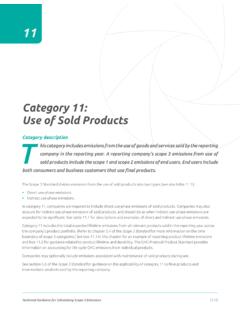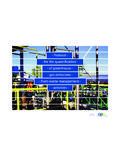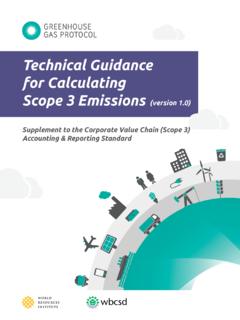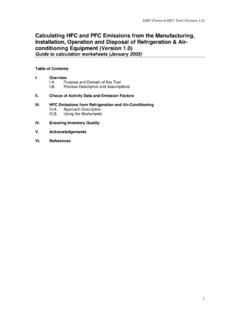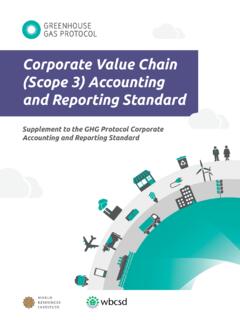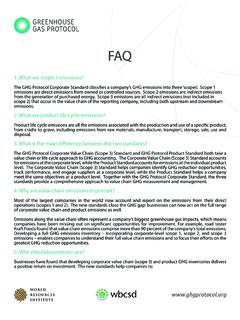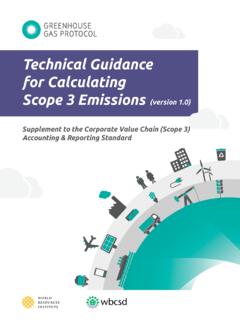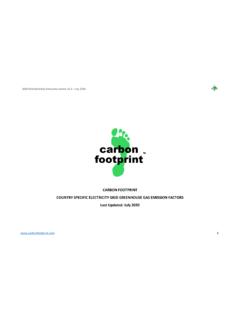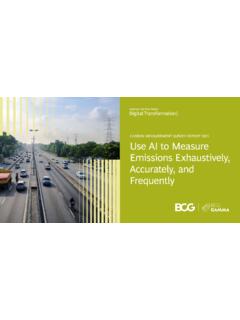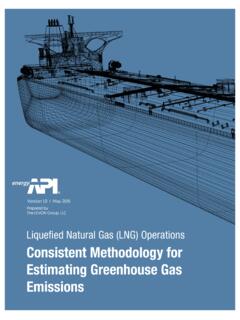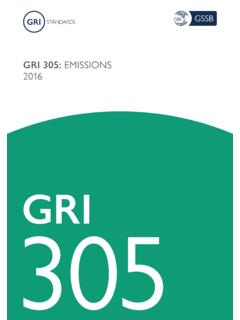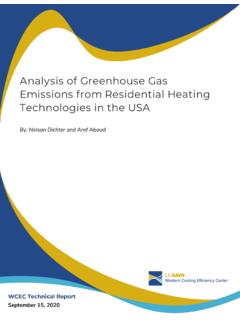Transcription of Scope 1 & 2 GHG Inventory Guidance
1 Scope 1 & 2 GHG Inventory Guidance Use to prepar e a GHG Inventory and quantif y emissionsThis dairy-specific Guidance document has been reviewed by the GHG Protocol and is in conformance with the requirements set forth in the Corporate Accounting and Reporting StandardNovember 2019 Table of ContentsIntroduction 2 Greenhouse Gas emissions Inventory Overview Inventory Management Plan 5 Developing an Inventory Management PlanImplementing an Inventory Management PlanGreenhouse Gas Accounting Terminology 7 Overview of Commonly Used Terms in GHG emissions AccountingEstablishing GHG Inventory Boundaries 11 Steps to Establish Organizational BoundariesSteps to Establish Operational Boundaries Scope 1 Stationary Combustion emissions 14 Accounting for emissions Associated with Stationary CombustionScope 1 Fugitive emissions 18 Steps for Collecting and QuantifyingSteps to Ensure and Document Quality ControlScope 1 Mobile Combustion 21 Steps for Collecting and QuantifyingSteps to Ensure and Document Quality ControlScope 2 emissions from Purchased Energy 24 Steps to Calculate Scope 2 emissions with the Location-Based Method and Market-Based ApproachMeasurement and Estimation Uncertainty of Greenhouse Gas emissions 26 Guidance and Tools to Assess emissions UncertaintyTarget Setting 27 Establishing Greenhouse Gas emissions Reduction TargetsOverview of Science-Based TargetsResources 29 Tools to Support Greenhouse Gas emissions Measurement, Reporting and Reduction Strategies1 2019 Innovation Center for Dairy.
2 All rights reserved. Table of ContentsNOTE: This document contains numerous hyperlinked tools and resources. It is, therefore, best viewed and used in PDF rather than print format. This resource was developed by Abby Snyder, Environmental Defense Fund (EDF) Climate Corps fellow and Sustainability Consultant with the Innovation Center for Dairy, with special thanks to the dairy processor community for their insights and to this Tool Increased requests to report greenhouse gas emissions (GHGs) and the establishment of industry-wide GHG reduction targets in the dairy sector have underscored the need for sector-specific Guidance on GHG Inventory development for the dairy processing industry. This document is a dairy-specific interpretation of recognized GHG accounting standards. It is intended to drive credible and consistent GHG emissions accounting across the dairy processing industry. The GHG Protocol Corporate Accounting and Reporting Standard serves as the foundation of this document.
3 The Corporate Standard is the most widely accepted and adopted GHG accounting Guidance also draws on existing accounting programs and protocols that are consistent with the GHG Protocol including: Environmental Protection Agency Center for Corporate Climate Leadership Greenhouse Gas Inventory Guidance1 yThe Climate Registry, General Reporting Protocol for the Voluntary Reporting Program, Version addition, this Guidance recommends using the Environmental Protection Agency Simplified GHG emissions Calculator3 to estimate and Inventory greenhouse gas emissions . This tool is specific to operations and uses the same emission factors as the Intelex software within the Aggregate Reporting Tool. Therefore, processors who do not opt into reporting into the Tool may still voluntarily calculate their own Scope 1 and 2 GHG footprint using the same methodologies as those who do report through the Tool. This ensures consistency and credibility of measurement and reporting to quantify the most accurate estimate of industry-wide processing emissions .
4 It is important to note that processors who opt into using the Aggregate Reporting Tool (Intelex) will have their Scope 1 and 2 GHG calculations completed for them. Users will still need to establish an Inventory management plan, set operational boundaries, collect activity data and enter activity data into the Aggregate Reporting Tool. The Tool will then calculate all GHG emissions and energy use based on the most up-to-date emission factors and best practices from the EPA Center for Corporate Climate Leadership. This ensures consistency across reporting facilities. Processors not using the Aggregate Reporting Tool will need to perform calculations independently following the Guidance in this document. Lastly, this document is intended to be used in conjunction with other Innovation Center for Dairy resources, including: yScope 3 GHG Inventory Guidance for Dairy Cooperatives and Processors yDairy Processor HandbookHow to Use This DocumentEach chapter provides an overview of the steps that a company can take to develop a Scope 1 and Scope 2 GHG emissions Inventory .
5 Chapters are also devoted to distilling the most important aspects of developing a rigorous, standard-based GHG Inventory and provide links to external resources that support the user in further exploring outlined concepts. External resources are hyperlinked into the text and outlined at the end of each chapter. Purpose and PrinciplesThe GHG emissions associated with dairy processing are dependent upon the nature of a company s operations and activities. Given the variability in processing operations and the associated GHG emissions , this document can be used to develop a robust GHG Inventory that is unique to each company s inherent characteristics, business goals and reporting requirements. The methodology outlined in this document is based on the GHG Protocol and is, therefore, compatible with most voluntary sustainability reporting , this document provides a framework for dairy processors to measure and report their GHG emissions in ways that are consistent with the dairy processor GHG emissions intensity metric defined in the Dairy Stewardship Commitment as Total GHG 2 2019 Innovation Center for Dairy.
6 All rights reserved. GHG Inventory Guidance GHG Inventory Guidanceemissions (tonnes, CO2e Scope 1 and 2) per lb. of production output. More specifically, the Guidance seeks to:1. Assist in preparing a GHG Inventory that represents a true and fair account of the company s emissions . 2. Simplify and reduce the costs of compiling a GHG Inventory . 3. Support reporting companies in meeting established business goals through the implementation of a credible accounting program. 4. Outline and reference resources that support consistent and transparent GHG accounting Gas InventoryA GHG Inventory provides a high-level perspective of a company s total emissions . A well-designed and maintained Inventory can be used as a management tool upon which a variety of business goals can be achieved, such as increased brand recognition, participation in a voluntary reporting program, or setting and achieving GHG emissions reduction targets. It is important to note that, while an Inventory can support a company s reporting goals, it is not to be confused with GHG emissions reporting, which is the presentation of emission data in formats tailored to the needs of various reporting requirements.
7 Figure 1 outlines the steps taken to develop an Inventory . Figure 2, Page 4, outlines the key principles of a GHG Inventory to ensure that the reporting information is industry-aligned through consistent reporting in the Dairy Stewardship Commitment. 3 2019 Innovation Center for Dairy. All rights reserved. GHG Inventory Guidance GHG Inventory GuidanceDesign Process Develop an Inventory Management Plan Establish organizational and operational boundariesGHG emissions Management Establish a reduction target Track emissions and trends Manage Inventory qualityGHG emissions Accounting Identify GHG emission sources Collect activity data Calculate GHG emissions (Figure 1) Key steps in designing a GHG inventoryNOTE: The Greenhouse Gas Reporting Program is an EPA emissions reporting program for large facilities that emit more than 25,000 metric tons of carbon dioxide equivalent. Companies that report to the GHGRP should follow the EPA s prescribed methodologies when reporting GHG emissions from sources identified on the GHGRP annual report (typically stationary combustion sources).
8 Companies must also include GHG emissions from other sources (refrigerant leaks, transportation emissions , purchased energy, etc.) when calculating their GHG intensity for the Stewardship Commitment s GHG Intensity metric. 4 2019 Innovation Center for Dairy. All rights reserved. GHG Inventory Guidance GHG Inventory GuidanceWorks CitedAdditional ResourcesNovembvr 20 1v9T1vrT1aT1l0 vrfCnl0 vt ls 1 IdCaovul2cl1ivhHNwovU1 2dTcI vUlIvD2P 20T1ivUcCsl2p Gvd00aGyy3C0ofiyhgEbhMAhovrfCnl0 v4 WCI01iovul2cl1ivhHNwovU 2 1lfv4 aT10C2 Wvm1T0 TpTfv9T1v0d vkTfc20l1iv4 aT10C2 Wvm1TW1lnvk 1 ICT2vhoNovd00aGyy3C0ofiyh1aRbF25ovembvr 20 1v9T1vrT1aT1l0 vrfCnl0 vt ls 1 IdCaovSl1pdvhHNQov:CnafCO svU-UvenCIICT2 Ivrlfpcfl0T1 Gvvd00aIGyy3C0ofiyhfidH.,16ovb12lcs7vxov The Handbook of Carbon Accounting, Routledge. 2016. ( ): GHG Protocol Corporate Accounting and Reporting Standard. (pp. 68): The boundaries of GHG emissions accounting and reporting should appropriately reflect the company s emissions and serve the business goals and decision-making needs of the company both internally and externally.
9 Completeness The emissions sources within the specified organizational and operational boundaries should be reported. Consistency To ensure that emission data can be tracked and compared within the reporting company over time, consistent application of accounting practices and quantification methodologies is All information regarding the processes, assumptions and limitations of the Inventory should be transparent and disclosed. Accuracy Data collection should be as accurate as possible, and uncertainties should be avoided as far as practical. NOTE: The GHG Protocol mandates that a company accounts for all its Scope 1 and 2 emissions within its organizational and operational boundaries. However, sources that are believed to be relatively small and/or insignificant may be calculated using simplified emissions calculation methods. These calculation methods are described in more detail in Chapter 11 of The Climate Registry s General Reporting Protocol.
10 (Figure 2) Principles and function of a GHG Inventory from the GHG Protocol5 2019 Innovation Center for Dairy. All rights reserved. GHG Inventory Guidance GHG Inventory GuidanceInventory Management Plan This chapter describes the development of an Inventory management plan (IMP), the systematic process of outlining the steps to create a credible and verifiable corporate-wide GHG at a Glance Developing a Plan Implementing a Plan Overcoming BarriersDeveloping an Inventory Management PlanAn Inventory Management Plan (IMP) should include the description of the managerial and technical responsibilities and arrangements made for collecting, calculating and maintaining GHG emission Establishing and maintaining an accurate IMP allows for tracking decisions and changes over time, creates institutional knowledge of accounting procedures, and allows for more efficient and effective emissions accounting and reporting. To assist with the development or improvement of an IMP, companies can refer to the templates listed in the Additional Resources section at the end of the chapter.
